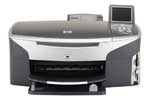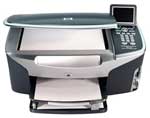
HP Photosmart 2710 multi-function printer scanner copier fax
Company: Hewlett-Packard
Price:$399.00
http://www hp.com
I’ve been a big fan of multi-function (printer-scanner-copier-fax) units for quite a while. The Weeks division of MyMac.com labs has been using HP’s Photosmart 2710 for several weeks, and is quite impressed with it.
Multi-function units have two main disadvantages compared to a collection of standalone units:
You’ve got all your eggs in one basket. If the one function of the unit requires service, because you can’t scan, for example, you’re dead in the water until the unit comes back.
The individual functions may not be as good quality as a stand-alone device. Compromises may have to be made to get printing, scanning, copying and faxing into one box at a reasonable price.
The upside to owning a multi-function device is that you don’t have to maintain three or four separate devices. You’ve got far fewer setup and connectivity headaches. A well-designed multifunction unit integrates all the different features. Having separate boxes may result in one box not playing nicely with another.
The HP Photosmart 2710 is HP’s top-of-the-line consumer MFC (multi-function) unit. Retailing for $399, it can be found for as low as $350 from reputable on-line dealers. The Photosmart name indicates that the print engine is capable of photo-quality printing. We’ll look more at that claim in a minute.
The 2710’s specs are impressive; this unit comes loaded with almost any feature you’d want in a MFC. The best features are the many built-in card reader slots and 802.11g networking capability, and the ability to use regular and photo quality ink cartridges.

Unpacking the printer was easy, just make SURE you remove all the various bits of tape and Styrofoam that lock the moving parts during shipment. Some are well hidden; you’re advised to follow the setup instructions.
Annoyingly, no USB cable is provided. While HP doesn’t hide this fact, you’d think that for $399 HP would toss in a USB cable.
Software installation was relatively quick and painless. I installed the software on both my dual 2 GHz Power Mac, as well an a old Gateway Pentium II that I keep on my network for running the odd PC-only application. The software bundle includes ReadIris Pro 9 for optical character recognition, which normally retails for $129.95. The software installs the HP ImageZone application, which is a central location for controlling the various functions of the 2710. The installer was well behaved, and placed the various applications controlled by ImageZone in a HP folder inside the Applications folder. An Uninstaller is included in case you need to remove the various pieces.
Since one of the prime features of the Photosmart 2710 is its ability to run on a network, I skipped the USB setup, and configured it via the built-in 10/100 Ethernet port. I chose to set up a manual IP address for the printer, although the 2710 can easily use DHCP. Manual IP addressing involves setting the desired address via the control panel on the printer, and then using the setup wizard from the computer to find the printer on the network. Setup worked the first time, even with the non-standard manual addressing.
Since the 2710 also allows wireless operation, I disconnected the Ethernet cable, and set up the unit for wireless operation. I found both manual setup and the Network Setup Assistant easy to use. Most users will choose the DHCP option, but network gurus can choose manual IP addressing and also turn on wireless WEP encryption.
As expected, the 2710 initial setup requires a cartridge calibration. One nice touch is the 2710’s ability to remember if a cart has already been calibrated, and not require a subsequent calibration. This feature comes in handy when you swap a regular cartridge for a photo-quality cartridge, and the replace the regular cartridge to resume normal quality printing. You won’t need to waste time and ink recalibrating the regular cartridge again; the HP already knows the settings.
Once up and running, I began to print. Right away, the HP print driver impressed me. I formerly owned a HP PSC 750 multi-function, which I learned to hate, mostly because of driver problems. Previous Macintosh OS X drivers by HP were, in a word, horrid. While print quality was good, the PSC 750 driver used way too many CPU cycles, did not play well with multiple users, and required reboots when the Mac lost contact with the printer. While I loved the 750 when I could get it to print, I eventually put it in a closet. And that was because I could not even give it away!
HP now has dedicated Macintosh programmers writing their Mac drivers and software, and it shows. During all my testing, I had no trouble with the HP stealing CPU cycles, and I could reliably print after switching from one user to another.
Digital camera cards
Before you can print, you’ve got to get your digital images into your computer. You can use your 2710 instead of a camera dock, if you prefer. The 2710 has slots to accommodate CompactFlash, SmartMedia, Memory Stick®, Secure Digital/MultiMedia/Secure MultiMedia, and xD-Picture Cards.
My Kodak Dx7440 uses Secure Digital SD cards, so that’s what I tested.
Pop the card into the slot, and the 2710 scans the card. You can print a contact sheet, print images directly from the card, or transfer the images to your computer. Personally, I can’t imagine printing directly from the card, as I always tweak my photos before using expensive photo paper!
Image transfers via the 2710 are started from HP’s ImageZone application, but use Apple’s Image Capture (included with OS X) to perform the actual transfers. HP includes a small application to funnel the images right into iPhoto, if that’s your photo management app of choice.
Printing
Getting good quality prints requires telling the printer what paper will be used. The print dialog lists over 20 different kinds of paper. You’ll find settings for N-up printing, reverse print order, double-sided printing, and ink density. Interestingly, there are also driver settings for contrast adjustment, sharpening, and red-eye removal.
Print quality from the 2710 was far better than the old PSC 750, and was immeasurably better than the Brother MFC 3810, which I used before the 2710. While it’s not as good as a stand-alone photo printer like the Epson Stylus 9000, the print quality is solidly good. I found the colors to be rich and saturated. Best-quality printing using the photo cartridges on HP glossy photo paper was generally excellent.
The print driver includes a setting to optimize photo printing on plain paper. I’ve often been disappointed with inkjet color printing using plain paper, but the 2710 does better than most. You’re not going to be framing a color print on plain paper, but it’s a great way to get quickie color output without using the expensive glossy photo paper. The 2710’s plain paper prints are, well, much less ugly than most. Kudos to HP for including this print setting.
Copying
One reason I’ve always like multifunction units is that they make good copiers. The 2710 can make both black and white and color copies, up to 99 at a time. You need not have your computer on to make copies, as you can access all the copy functions from the 2710’s front panel controls. Copying was trouble-free. I used the 2710’s ability to change the default copy settings to “Faster” to save that expensive HP ink.
Scanning
Scanning can be a whole subject of its own, especially photo scanning What DPI to use, what bit depth to scan at, and other questions spring up to confuse the average user. The 2710 has capable hardware; it up to you to exploit it to best advantage.
Like almost all other 2710 functions, you begin the scanning process with the ImageZone application. Choose Scan Picture, and the HP Image Scan application launches and begins a preview scan. Once the preview is done, you can crop it before scanning, and do basic straightening or rotating. You can choose from several settings (Text, Photo, Mixed Color, or Mixed Grayscale) or choose custom to pick your own resolution. Scans can be directly sent to the application of your choice or saved to disk in one of twelve formats, including Photoshop, PDF, TIFF, and JPG.
Test scans were generally good quality, but not as good as those from a dedicated scanner. The average user should be happy with the 2710’s scans.
Faxing
While I’m not a heavy fax user, I found the 2710’s fax capabilities easy to use. Like copying, the fax features do not need the computer to be on; it’s a perfectly capable stand-alone fax machine. I was extremely impressed with the fax setup instructions. People who struggled with fax-phone splitters, answering machine settings, DSL lines, and other impediments to easy faxing know how hard it can be to get a fax machine to play nice with other devices. HP provides very detailed flow charts that walk the user carefully through the various setup options. My setup went flawlessly the first time, with the HP instructions not missing a step.
Actual faxing was uneventful. In light testing faxes came and went with no problems.
Connectivity
The 2710 has USB 2, 10/100 Ethernet, and wireless connections. Given that less expensive HP multi-function models provide the same features without Ethernet or wireless capability, I did not spend much time using the USB cable.
Both wired and wireless networking was a breeze to set up. The Network Setup Assistant was quick and easy to use.
Wireless throughput drops as the distance from the base station to the receiving unit goes up. Most of my testing had the 2710 located only a few feet away from the base station. At these close distances, there was little significant difference between wired and wireless operation speeds. Wired was faster, but the difference was not annoying. Only when making large scans was wireless’ slower speed noticeable.
I did relocate the printer about 50 feet away in another room for a few tests, and that did result in noticeably greater times to send a print job, or to bring a scan from the 2710 to my Mac. But if you need a wireless access to your printer, slower access times may be a small price to pay, especially if running cable is not an option.
Documentation
HP has done it right, with a good printed manual that has an outstanding section of setting up the fax functions. Apple Help files are included, and the ImageZone software provides links to HP on-line help. To test their Technical Support personnel, I call twice. One call was quite simple, asking how to change cartridges, and the second asked more detailed questions about manual IP addressing on a network. Wait time were short on both calls, and the Tech Support agent provided the right answer in short order.
Conclusion
The Photosmart 2710 is an expensive unit ($399) but you get plenty of capability for your money. Mac users finally have reliable drivers. Setup instructions, especially for faxing are very comprehensive.
Print quality is quite good; as good as less expensive stand-alone photo printers. If you use the photo cartridges and HP glossy paper, you’ll be very pleasantly surprised at how good the printing can be. Driver settings for many different kinds of paper make it easy to get the right amount of ink on the paper for optimum quality. Print speed, while not blazing, won’t keep you waiting forever.
Network connectivity is easy. Wireless access has some performance hit, but it can make printer location far easier.
For users who are willing to pay top dollar for a full-featured multi-function printer with plenty of connectivity options, and surprisingly good printing, the Photosmart 2710 is a fine choice.

Leave a Reply
You must be logged in to post a comment.